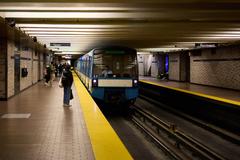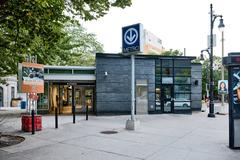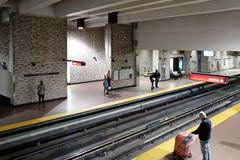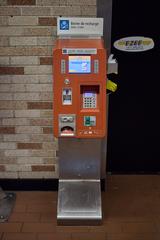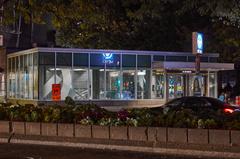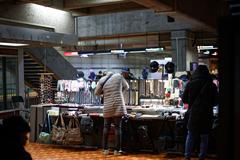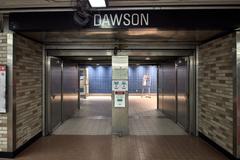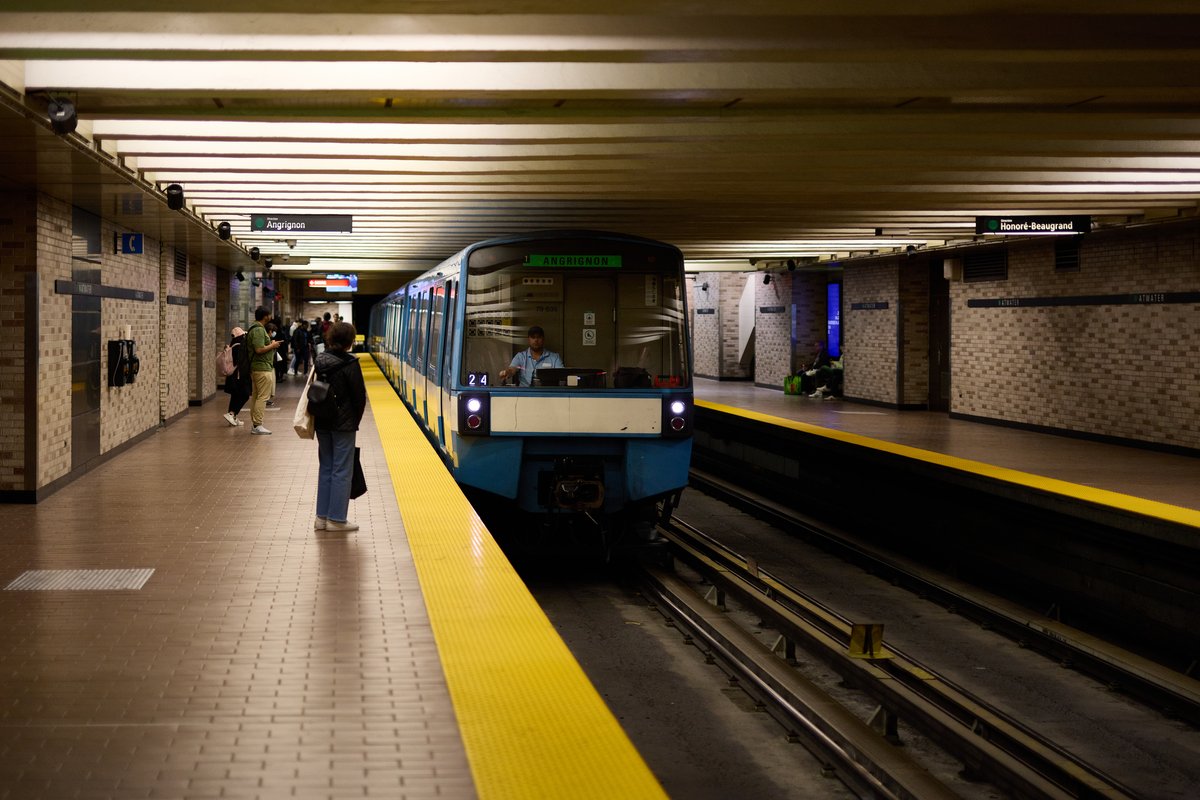
Atwater Market Montreal: Visiting Hours, Tickets, and Historical Significance
Date: 15/06/2025
Introduction
Atwater Market, nestled in Montreal’s vibrant Southwest borough, stands as an enduring symbol of the city’s cultural heritage, architectural elegance, and renowned culinary scene. Since its opening in 1933, the market has been a cornerstone of community life, commerce, and gastronomy, attracting both residents and tourists in search of an authentic Montreal experience. Named after Edwin Atwater, a notable 19th-century businessman and municipal alderman, the market was established near the historic Lachine Canal—a vital artery that shaped Montreal’s industrial and economic landscape (Wikipedia; National Geographic).
Distinguished by its Art Deco architecture, designed by Ludger Lemieux, and its ongoing role in supporting Quebec’s agricultural and artisanal economies, Atwater Market remains a must-visit destination. This guide covers everything you need to know: history, architecture, practical visitor tips, events, accessibility, and how to make the most of your visit.
Table of Contents
- Introduction
- Historical Development and Community Impact
- Architectural Significance
- Visitor Information: Location, Hours, and Accessibility
- Vendor Highlights and Culinary Experiences
- Seasonal Events and Festivals
- Art, Culture, and Community Engagement
- Practical Tips for Visitors
- FAQs
- Plan Your Visit and Stay Updated
- References
Historical Development and Community Impact
Origins and Naming
Atwater Market opened its doors in April 1933, named after Atwater Avenue, itself a tribute to Edwin Atwater (1808–1874), an influential businessman and alderman (Wikipedia). Its creation was part of a citywide initiative to modernize public commerce, replacing informal street vendors with a permanent, hygienic, and community-oriented space (Burisch, 2010).
The market’s location, at the crossroads of Saint-Henri, Little Burgundy, and Pointe Saint-Charles, capitalized on proximity to the Lachine Canal. This waterway, completed in 1825, was pivotal in Montreal’s industrialization, connecting neighborhoods and supporting local economies (National Geographic).
Socioeconomic Role
From its inception, Atwater Market was envisioned as a people’s market, prioritizing local farmers, small-scale producers, and artisans over large commercial grocers (Factsgem). This commitment fostered a strong sense of community and supported the region’s agricultural economy. The market regularly partners with local charities and supports food drives, reinforcing its role as a socially responsible institution.
Neighborhood revitalization, especially after the reopening of the Lachine Canal in 2002, has driven significant gentrification and investment in the area. Property values in the borough rose notably between 2002 and 2006, reflecting the market’s influence on urban development (Wikipedia).
Architectural Significance
Art Deco Design
Atwater Market is celebrated for its striking Art Deco architecture—one of Montreal’s finest examples (Burisch, 2010). Designed by Ludger Lemieux, the building features:
- Stepped Clock Tower: The iconic ziggurat-style tower is a local landmark and a hallmark of Art Deco design.
- Symmetrical Facade: Repetitive vertical lines and geometric ornamentation evoke modernity and order.
- Materials: Durable brick, stone, and concrete, reflecting 1930s aspirations of progress and civic pride.
- Functional Layout: The original design included ground-floor produce stalls, butcher shops on the upper level, administrative offices, and a vast upstairs hall that was the city’s largest gathering space at the time.
The building was lauded at its debut as “one of the most modern, hygienic and elaborate public buildings in the city,” reflecting the era’s emphasis on public health (Burisch, 2010).
Significance in Montreal’s Architectural Heritage
Montreal is renowned for its architectural diversity, and Atwater Market stands out among the city’s few prominent Art Deco landmarks, alongside the Aldred Building and Université de Montréal main building (The Design Gesture). Its location and style underscore its enduring civic importance.
Evolution and Preservation
The market building has undergone sensitive renovations, especially to accommodate seasonal changes—removable walls provide comfort in winter, while summer brings open-air stalls (Free Activities). Preservation efforts maintain its historic exterior, ensuring its legacy for future generations.
Visitor Information: Location, Hours, and Accessibility
Location & Getting There
- Address: 138 Avenue Atwater, Montreal, QC H4C 2G3 (Wikipedia)
- By Metro: Atwater or Lionel-Groulx stations (Green and Orange lines) are a short walk away.
- By Bike: Direct connection to the Lachine Canal bike path; BIXI stations nearby.
- By Car: 440 paid parking spaces are available, though spots fill quickly on weekends (Marchés Publics FAQ).
Opening Hours & Admission
- Monday to Friday: 7:00 a.m. – 6:00 p.m.
- Saturday & Sunday: 7:00 a.m. – 5:00 p.m.
- Admission: Free; no tickets required
- Seasonal Variations: Outdoor areas and vendor stalls expand May–October. Always verify hours on the official website before visiting.
Accessibility
- Fully wheelchair accessible, with ramps and wide aisles.
- Accessible public washrooms are available.
- Most vendors accept cards, but cash is useful for smaller stalls.
Vendor Highlights and Culinary Experiences
Atwater Market is a haven for foodies, offering a rich variety of fresh and prepared foods:
- Fresh Produce & Florists: Seasonal fruits, vegetables, and flowers from local growers.
- Butchers & Cheesemongers: Family-run shops offer high-quality meats, artisanal cheeses, and gourmet delicacies.
- Prepared Foods: Enjoy specialties from Satay Brothers (Singaporean), Le Petit Sao (Vietnamese), Lucille’s au Marché (seafood), Brûlerie Aux Quatre Vents (coffee and pastries), and Havre aux Glaces (ice cream and sorbets) (Eater Montreal).
- Bakeries & Cafés: Première Moisson is especially popular for fresh bread and pastries.
- Outdoor Dining: Expanded seating and food stalls in warmer months create a vibrant atmosphere.
Seasonal Events and Festivals
Annual Highlights
- Les Sucres (Sugar Season): Held in early April, featuring maple syrup treats and sugar shack dishes (marchespublics-mtl.com).
- Saint-Jean-Baptiste Day: Local celebrations and special market hours.
- Christmas Village: A festive market with artisan stalls, holiday foods, and family activities.
- Community Festivals: Street festivals in Little Burgundy and along the Lachine Canal feature live music, art, and multicultural food.
For up-to-date event info, check the events page or mtl.org’s festival guide.
Art, Culture, and Community Engagement
Public Art and Architecture
Atwater Market’s Art Deco building serves as a canvas for public art projects and temporary installations, especially during citywide events like the MURAL Festival.
Atwater Library and Computer Centre
Located nearby, the Atwater Library offers cultural programming, including a popular Lunchtime Series of lectures and performances—free and open to all.
Social Responsibility
The market and surrounding organizations prioritize:
- Accessibility and Inclusion: Barrier-free facilities and programming (Old Port of Montreal Corporation).
- Sustainability: Eco-friendly practices, waste reduction, and support for local agriculture.
- Community Engagement: Partnerships with charities and social initiatives, such as food drives and educational outreach.
Practical Tips for Visitors
- Best Times to Visit: Weekday mornings for a quieter atmosphere; weekends for vibrant market energy.
- Bring: Reusable bags/containers for sustainable shopping; cash for small purchases.
- Pets: Not allowed inside the market, except certified service animals.
- Language: French is predominant; most vendors also speak English.
- Lost & Found, Wi-Fi, and Amenities: Available on-site.
- Rules: No smoking; bikes must be walked inside the market area.
FAQs
Q: Do I need tickets to enter Atwater Market?
A: No, admission is free for all visitors.
Q: What are the best visiting hours?
A: Weekday mornings are quieter; weekends are more lively.
Q: Is Atwater Market wheelchair accessible?
A: Yes, fully accessible, including washrooms.
Q: Are pets allowed?
A: Only certified service animals are permitted.
Q: Are guided tours available?
A: Occasionally, yes—check the official website for updates.
Plan Your Visit and Stay Updated
- Check the official Atwater Market website for hours, special events, and visitor information.
- Download the Audiala app for real-time updates and curated experiences.
- Explore the events page.
- Follow Atwater Market and Audiala on social media for the latest news.
Summary
Atwater Market is a vibrant emblem of Montreal’s history, architectural beauty, and dynamic culinary culture. With its Art Deco design, diverse local products, year-round festivals, and commitment to accessibility and sustainability, the market offers an enriching experience for all. Whether you’re savoring Quebec’s best artisanal foods, admiring historic architecture, or participating in community celebrations, Atwater Market is a must-visit destination.
References
- Atwater Market Wikipedia, 2025
- Burisch, 2010, Art Deco Architecture of Atwater Market
- National Geographic, Montreal Historic Food Markets, 2024
- Factsgem, Facts about Atwater Market Montreal, 2025
- The Design Gesture, Montreal Architecture, 2024
- Free Activities, Atwater Market Visitor Guide, 2024
- mtl.org, Public Markets in Montreal, 2025
- marchespublics-mtl.com, Official Atwater Market Website, 2025
- marchespublics-mtl.com, Les Sucres at Atwater Market, 2025
- Old Port of Montreal Corporation, Social Responsibility and Accessibility, 2025
- Montreal Visitors Guide, Atwater Market Overview, 2025
- Trylon Montreal, 5 Must-Try Montreal Markets, 2024
- Eater Montreal – Best Food at Atwater Market
